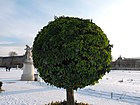Note: This is a project under development. The articles on this wiki are just being initiated and broadly incomplete. You can Help creating new pages.
Difference between revisions of "Laurus nobilis"
| Line 1: | Line 1: | ||
[[File:2010-08-01 Laurus nobilis.jpg|thumb|right]] | [[File:2010-08-01 Laurus nobilis.jpg|thumb|right]] | ||
| + | '''Laurus nobilis''' is an evergreen shrub or small tree growing from 2 - 15 metres tall. The bay tree is a very ornamental plant that is often cultivated for its use as a food flavouring and medicine. The plant has been held in high esteem since ancient times. | ||
==Uses== | ==Uses== | ||
| − | {{Uses|}}, {{Uses|}}, {{Uses|}}, {{Uses| | + | {{Uses|Hysteria}}, {{Uses|Amenorrhoea}}, {{Uses|Flatulent colic}}, {{Uses|Arthritic aches}}.<ref name="Uses"/> |
==Parts Used== | ==Parts Used== | ||
| − | {{Parts Used|}}, {{Parts Used| | + | {{Parts Used|Leaves}}, {{Parts Used|Dried fruits}}. |
==Chemical Composition== | ==Chemical Composition== | ||
| Line 28: | Line 29: | ||
==Habit== | ==Habit== | ||
| − | {{Habit|}} | + | {{Habit|Evergreen tree}} |
==Identification== | ==Identification== | ||
| Line 47: | Line 48: | ||
==Mode of Propagation== | ==Mode of Propagation== | ||
| − | {{Propagation|}} | + | {{Propagation|Seeds}}, {{Propagation|Cuttings of half-ripe wood}}, {{Propagation|Cuttings of mature side shoots}}, {{Propagation|Layering}}. |
==How to plant/cultivate== | ==How to plant/cultivate== | ||
| − | <ref name="How to plant/cultivate"/> | + | Bay tree is a plant of Mediterranean climates, though is quite adaptable and has been cultivated successfully from warmer areas in the temperate zone to tropical regions.<ref name="How to plant/cultivate"/> |
==Commonly seen growing in areas== | ==Commonly seen growing in areas== | ||
| − | {{Commonly seen|}}, {{Commonly seen|}}, {{Commonly seen|}}, {{Commonly seen| | + | {{Commonly seen|Damp rocks}}, {{Commonly seen|Ravines}}, {{Commonly seen|Thickets}}, {{Commonly seen|Old walls}}. |
==Photo Gallery== | ==Photo Gallery== | ||
| Line 66: | Line 67: | ||
<references> | <references> | ||
| − | <ref name="chemical composition">[ | + | <ref name="chemical composition">[Chemistry]</ref> |
| − | <ref name="Leaf">[ | + | <ref name="Leaf">[Morphology]</ref> |
| − | <ref name="How to plant/cultivate">[ | + | <ref name="How to plant/cultivate">[http://tropical.theferns.info/viewtropical.php?id=Laurus+nobilis Cultivation]</ref> |
<ref name="Uses">Indian Medicinal Plants by C.P.Khare</ref> | <ref name="Uses">Indian Medicinal Plants by C.P.Khare</ref> | ||
</references> | </references> | ||
==External Links== | ==External Links== | ||
| − | * [ ] | + | * [https://www.sciencedirect.com/topics/immunology-and-microbiology/laurus-nobilis Laurus nobilis on sciencedirect.com] |
| − | * [ ] | + | * [https://uses.plantnet-project.org/en/Laurus_nobilis_(PROSEA) Laurus nobilis on uses.plantnet-project.org] |
| − | * [ ] | + | * [https://pfaf.org/user/plant.aspx?LatinName=Laurus+nobilis Laurus nobilis on pfaf.org] |
[[Category:Herbs]] | [[Category:Herbs]] | ||
[[Category:Pages without herbs images]] | [[Category:Pages without herbs images]] | ||
Latest revision as of 14:48, 30 May 2020
Laurus nobilis is an evergreen shrub or small tree growing from 2 - 15 metres tall. The bay tree is a very ornamental plant that is often cultivated for its use as a food flavouring and medicine. The plant has been held in high esteem since ancient times.
Contents
- 1 Uses
- 2 Parts Used
- 3 Chemical Composition
- 4 Common names
- 5 Properties
- 6 Habit
- 7 Identification
- 8 List of Ayurvedic medicine in which the herb is used
- 9 Where to get the saplings
- 10 Mode of Propagation
- 11 How to plant/cultivate
- 12 Commonly seen growing in areas
- 13 Photo Gallery
- 14 References
- 15 External Links
Uses
Hysteria, Amenorrhoea, Flatulent colic, Arthritic aches.[1]
Parts Used
Chemical Composition
Common names
| Language | Common name |
|---|---|
| Kannada | |
| Hindi | |
| Malayalam | |
| Tamil | |
| Telugu | |
| Marathi | |
| Gujarathi | |
| Punjabi | |
| Kashmiri | |
| Sanskrit | |
| English |
Properties
Reference: Dravya - Substance, Rasa - Taste, Guna - Qualities, Veerya - Potency, Vipaka - Post-digesion effect, Karma - Pharmacological activity, Prabhava - Therepeutics.
Dravya
Rasa
Guna
Veerya
Vipaka
Karma
Prabhava
Habit
Identification
Leaf
| Kind | Shape | Feature |
|---|---|---|
Flower
| Type | Size | Color and composition | Stamen | More information |
|---|---|---|---|---|
| {{{5}}} |
Fruit
| Type | Size | Mass | Appearance | Seeds | More information |
|---|---|---|---|---|---|
Other features
List of Ayurvedic medicine in which the herb is used
Where to get the saplings
Mode of Propagation
Seeds, Cuttings of half-ripe wood, Cuttings of mature side shoots, Layering.
How to plant/cultivate
Bay tree is a plant of Mediterranean climates, though is quite adaptable and has been cultivated successfully from warmer areas in the temperate zone to tropical regions.[4]
Commonly seen growing in areas
Damp rocks, Ravines, Thickets, Old walls.
Photo Gallery
- ==
References
- ↑ Indian Medicinal Plants by C.P.Khare
- ↑ [Chemistry]
- ↑ [Morphology]
- ↑ Cultivation
External Links
- Pages with broken file links
- Ayurvedic Herbs known to be helpful to treat Hysteria
- Ayurvedic Herbs known to be helpful to treat Amenorrhoea
- Ayurvedic Herbs known to be helpful to treat Flatulent colic
- Ayurvedic Herbs known to be helpful to treat Arthritic aches
- Herbs with Leaves used in medicine
- Herbs with Dried fruits used in medicine
- Habit - Evergreen tree
- Index of Plants which can be propagated by Seeds
- Index of Plants which can be propagated by Cuttings of half-ripe wood
- Index of Plants which can be propagated by Cuttings of mature side shoots
- Index of Plants which can be propagated by Layering
- Herbs that are commonly seen in the region of Damp rocks
- Herbs that are commonly seen in the region of Ravines
- Herbs that are commonly seen in the region of Thickets
- Herbs that are commonly seen in the region of Old walls
- Herbs
- Pages without herbs images




